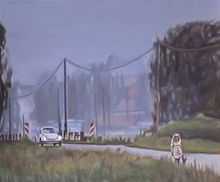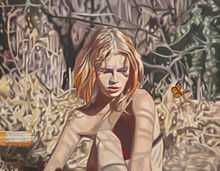Sylvester Engbrox

Sylvester Engbrox is a contemporary German painter. He was born in 1964 in Kleve, North Rhine-Westphalia. He lives and works in Paris.
Biography
In 1983, Engbrox obtained a baccalauréat specialising in graphic arts. He then decided to start earning as a traditional graphic artist, assistant photographer on set and a light technician. These experiences allowed him to work with Wolfgang Flur from the group Kraftwerk, on photo shoot locations. In 1984, he began to paint. In 1986, he left Düsseldorf to live in Paris, and turned to photography. From 1988 to 1991, he was a student at the École nationale supérieure de la photographie, in Arles (Bouches-du-Rhône). There he was a student of Arnaud Claass, Christian Milovanoff and Christian Gattinoni. He also had the opportunity to be Larry Fink’s photographic assistant.
From 1999 to 2005 he created and managed with two friends in Paris an independent music label, Home Laboratoire Moderne. He also contributed to the writing and the composition of titles with Sporto Kantes. In 2005, he set up a studio and dedicated himself to painting for good.
Work
The first three works featured in his catalogue are from 1994: Helen, Hotel Aya and Air Disaster 1. These canvases are oil paintings based on images found in small format and poorly printed general press. The artist’s work mainly introduces characters in elaborate and improbable settings. His first exhibition took place in 2008 at Galerie VivoEquidem in Paris. With Jean-Luc Chalumeau, who wrote the preface of the 2008 catalogue, we reached the conclusion that Sylvester Engbrox didn’t belong to any school, but that he emanated directly from the complexity of the contemporary world, bombarded by mainly digital images. The fact that Sylvester Engbrox grew up in Düsseldorf in the seventies and eighties and had very thorough training to be a photographer in Arles is significant. For him, the visible world of his youth, from the remainders of New Objectivity to flashes of Gerhard Richter through images, circulated on a large scale, to the Red Army Faction's acts, formed an obvious nourishing ‘foundation’. To that is add Andy Warhol, David Lynch’s cinema, Bernd and Hilla Becher’s photography and Kraftwerk’s music. Thus, Sylvester Engbrox, due to his culture of origin and his photography training, has always been interested in a certain projection of reality. He, who for years methodically compiled and filed tens of thousands of pictures from the general press, television magazines and the Internet, quite quickly realised that the world in its sensitive domain, if it definitely exists, is not as true as is said or that we are led to believe. Ultimately, he noted then accepted that the world is the total of the facts and not things (Wittgenstein, Tractatus, 1.1). The digital era that Engbrox practically saw born and that he closely followed has confirmed this fact. Indeed, the ‘digital thing’ forgets nothing, throws away nothing, it accumulates relentlessly all realities one after the other.

Quotes
- ‘I paint based on images found in holiday catalogues, television programmes… I have collected large quantities of images to class them according to an invented typology. This part of the work today is through the Internet and my own photographic archives. This completely useless catalogue of a depicted world clarifies nothing: the more images we see, the less we understand. But this ordering, this perpetual comparison of one portrayal with another ends by creating bridges between some of them. Sometimes these confrontations lead to a new image. It is this image, which appeared without me knowing, that I paint. My painting comes from this obsessive filing.’ Sylvester Engbrox, February 2008.
- ‘When a hard disk fails, a recovery programme is launched to try to save the data. My canvases try to repair a time-space that has been disrupted following a crash, to redefine it, by overlapping what remains: bits of gathered images.’ Sylvester Engbrox, February 2008.
- ‘His painting is totally representative of our period. Clearly figurative, linked completely to the long pictorial history, without any complex regarding official views, it opens up our imaginative fields. It proves to us, better than long speeches, the amazing vitality of painting which crosses technical evolutions (photo, video, Internet…) by digesting them greedily.’ Gérard Gamand, Azart magazine, September 2008.
- ‘From the heart of the proliferating mass of Web images, Sylvester Engbrox picks out those which will allow him, those to which he is sensitive, not to accomplish who knows what desire by deluding it (which is what the academic XIXth century nude painters did), but to methodically disappoint it by exposing his machinery.’ Jean-Luc Chalumeau, Sylvester Engbrox, exhibition catalogue, 2008.
- ‘In this way, the artist recognises it. He is only an intermediary, a tool, a machine. It is why he explains nothing in his painting, he suggests nothing, neither eroticism, nor guilt, or suffering. He is only showing. And strictly speaking, it is really a question then of a 'show'.’ Max Torregrossa, Sylvester Engbrox, exhibition catalogue, January 2008.
Bibliography
- Max Torregrossa : Approches techniques [exhibition catalogue], 2008.
- Léo Pajon: Sylvester Engbrox, Arts Magazine, March 2008, p. 43.
- Lydia Harambourg: Sylvester Engbrox, La Gazette de l’Hôtel Drouot n° 10, 14 March 2008, p. 278.
- Jean-Luc Chalumeau: Sylvester Engbrox : Un déplacement du désir de peindre, Verso n° 49, April 2008, p. 24-25.
- Gérard Gamand: Sylvester Engbrox : Les images du siècle, Azart n° 34, September–October 2008, p. 50-58.
- Ulrich Schönleber: Hyperceptions, ParisBerlin n° 44, September 2009, p. 40-45.
- Naissance de la Modernité, Mélanges offerts à Jacques Vilain, Editions du Relief, Paris, 2009, ISBN 978-2-35904-000-5
- Florence Besson, Elle, n° 3386, November 2010, p. 58.
- Arts Magazine, n° 51, Dezember 2010, Dans les galeries en décembre, p. 36.
- Sylvester Engbrox, Follow Me, Patrick Williams, éditions VivoEquidem, 80 pages, Paris, 2010, ISBN 978-2-9531926-1-2
See also
External links
- Artist’s website
- Galerie VivoEquidem website
- Audiovisual Encyclopedia of contemporary art
- Christian Gattinoni: Dans la déprise du monde, peindre encore, LaCritique
- Jean-Luc Chalumeau: Sylvester Engbrox : Un déplacement du désir de peindre, Chroniques: les Archives